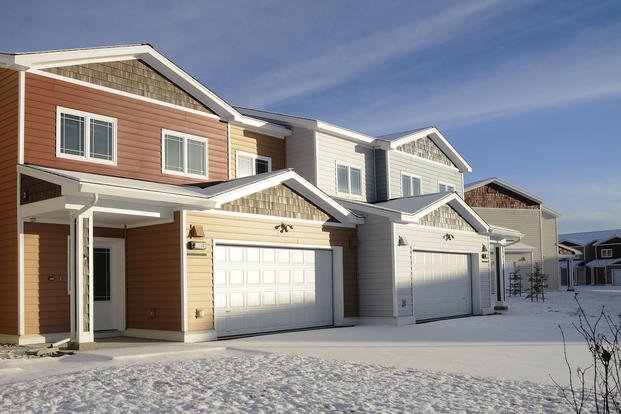 Military Update: Basic Allowance for Housing (BAH) paid to a million service members living off base in the United States will rise an average of 3.4 percent on Jan. 1, which for a second straight year will not be enough to match rising rents and utility costs nationwide. Defense pay officials are executing a five-year plan, which Congress approved, to dampen stateside housing allowances gradually, so that by 2019 members will be paying five percent of < housing costs out of pocket. In 2016, the "cost share" for BAH recipients will be two percent of national average housing costs for their pay grade. It was one percent in 2015. The negative impact of BAH cost sharing on purchasing power will range from $24 to $57 a month, depending on rank and family status. In a statement, Defense officials called the computation for slowing overall compensation growth "fair, responsible and sustainable...[T]he overall military pay and benefits package remains robust and healthy." Starting in 2015, BAH recipients lost more value from their housing allowances, about $300 annually, when the rate-setting formula no longer included dollars to cover the cost of renters' insurance, which military folks often buy to protect their personal affects from theft, fire or other risks. BAH payments in 2016 still will total more than $21 billion. Rates will rise across most of more than 300 Military Housing Areas. The average monthly increase, despite "cost sharing," will be $54. Actual increases for individuals will vary based on where members are assigned, rank or pay grade, and whether members qualify for the higher "with dependents" BAH. In some areas, BAH rates will fall Jan 1. The BAH < program, < however, continues to provide individual rate protection so no current recipients will see their BAH fall to revised rates. Rate protection recognizes that members commit to multi-year leases or contracts and need a stable allowance, unaffected by falling markets or the new cost-share formula, at least until they move to new assignments or their dependency status changes. To recalculate rates annually, Defense officials gather rental cost data from across the United States, including Alaska and Hawaii. Local military housing offices provide critical help by directing data collection away from apartment complexes and individual housing units unsuitable for the military. Rates are reset based on median current market rents and average utility costs (electricity, heat, water and sewer) for six housing profiles -- a combination of dwelling type (apartments, townhouses or single family homes) and number of bedrooms. Individual rates reflect local costs for housing appropriate for each pay grade, with and without dependents. Some areas will see sharp BAH hikes, such as an average increase of 12.2 percent in Everett, Wash., and a 7.9 percent jump in Panama City, Fla. But BAH for new arrivals will fall in other areas, including by 3.1 percent in Gulfport, Miss., and by 2.2 percent at Fort Riley, Kan. When the BAH program was established for setting stateside housing allowances, initial rates covered only 80 percent of members' rental costs. More than a decade ago, Congress decided to phase out that onerous 20 percent cost-sharing formula and completed the task in 2005. Last year, accepting military leaders' argument that they needed to free up housing allowance dollars for other readiness needs, Congress began to reverse course on full BAH and to slow automatic < growth in rates. Service members living off base overseas don't receive BAH. Instead they get an Overseas Housing Allowance based on what individual members actually pay to rent local housing. OHA gets adjusted periodically to keep pace with the dollar's changing value against local currency. Food Allowances -- Also Jan. 1 new basic allowance for subsistence (BAS) rates take effect but the change is very modest. The monthly food allowance for officers will be $253.63 < per month, a 25-cent increase. Enlisted BAS will be $368.29, a 37-cent increase. BAS adjustments are linked to changes in food prices as measured by the U.S. Department of Agriculture's cost of food at home index, which only the last year rose by only 0.1 percent. Send comments to Military Update, P.O. Box 231111, Centreville, VA, 20120, email milupdate@aol.com or twitter: Tom Philpott @Military_Update # # # # Tom Philpott has been breaking news for and about military people since 1977. After service in the Coast Guard, and 17 years as a reporter and senior editor with Army Times Publishing Company, Tom launched "Military Update," his syndicated weekly news column, in 1994. "Military Update" features timely news and analysis on issues affecting active duty members, reservists, retirees and their families. Visit Tom Philpott's Military Update Archive to view his past articles. Tom also edits a reader reaction column, "Military Forum." The online "home" for both features is Military.com.
Military Update: Basic Allowance for Housing (BAH) paid to a million service members living off base in the United States will rise an average of 3.4 percent on Jan. 1, which for a second straight year will not be enough to match rising rents and utility costs nationwide. Defense pay officials are executing a five-year plan, which Congress approved, to dampen stateside housing allowances gradually, so that by 2019 members will be paying five percent of < housing costs out of pocket. In 2016, the "cost share" for BAH recipients will be two percent of national average housing costs for their pay grade. It was one percent in 2015. The negative impact of BAH cost sharing on purchasing power will range from $24 to $57 a month, depending on rank and family status. In a statement, Defense officials called the computation for slowing overall compensation growth "fair, responsible and sustainable...[T]he overall military pay and benefits package remains robust and healthy." Starting in 2015, BAH recipients lost more value from their housing allowances, about $300 annually, when the rate-setting formula no longer included dollars to cover the cost of renters' insurance, which military folks often buy to protect their personal affects from theft, fire or other risks. BAH payments in 2016 still will total more than $21 billion. Rates will rise across most of more than 300 Military Housing Areas. The average monthly increase, despite "cost sharing," will be $54. Actual increases for individuals will vary based on where members are assigned, rank or pay grade, and whether members qualify for the higher "with dependents" BAH. In some areas, BAH rates will fall Jan 1. The BAH < program, < however, continues to provide individual rate protection so no current recipients will see their BAH fall to revised rates. Rate protection recognizes that members commit to multi-year leases or contracts and need a stable allowance, unaffected by falling markets or the new cost-share formula, at least until they move to new assignments or their dependency status changes. To recalculate rates annually, Defense officials gather rental cost data from across the United States, including Alaska and Hawaii. Local military housing offices provide critical help by directing data collection away from apartment complexes and individual housing units unsuitable for the military. Rates are reset based on median current market rents and average utility costs (electricity, heat, water and sewer) for six housing profiles -- a combination of dwelling type (apartments, townhouses or single family homes) and number of bedrooms. Individual rates reflect local costs for housing appropriate for each pay grade, with and without dependents. Some areas will see sharp BAH hikes, such as an average increase of 12.2 percent in Everett, Wash., and a 7.9 percent jump in Panama City, Fla. But BAH for new arrivals will fall in other areas, including by 3.1 percent in Gulfport, Miss., and by 2.2 percent at Fort Riley, Kan. When the BAH program was established for setting stateside housing allowances, initial rates covered only 80 percent of members' rental costs. More than a decade ago, Congress decided to phase out that onerous 20 percent cost-sharing formula and completed the task in 2005. Last year, accepting military leaders' argument that they needed to free up housing allowance dollars for other readiness needs, Congress began to reverse course on full BAH and to slow automatic < growth in rates. Service members living off base overseas don't receive BAH. Instead they get an Overseas Housing Allowance based on what individual members actually pay to rent local housing. OHA gets adjusted periodically to keep pace with the dollar's changing value against local currency. Food Allowances -- Also Jan. 1 new basic allowance for subsistence (BAS) rates take effect but the change is very modest. The monthly food allowance for officers will be $253.63 < per month, a 25-cent increase. Enlisted BAS will be $368.29, a 37-cent increase. BAS adjustments are linked to changes in food prices as measured by the U.S. Department of Agriculture's cost of food at home index, which only the last year rose by only 0.1 percent. Send comments to Military Update, P.O. Box 231111, Centreville, VA, 20120, email milupdate@aol.com or twitter: Tom Philpott @Military_Update # # # # Tom Philpott has been breaking news for and about military people since 1977. After service in the Coast Guard, and 17 years as a reporter and senior editor with Army Times Publishing Company, Tom launched "Military Update," his syndicated weekly news column, in 1994. "Military Update" features timely news and analysis on issues affecting active duty members, reservists, retirees and their families. Visit Tom Philpott's Military Update Archive to view his past articles. Tom also edits a reader reaction column, "Military Forum." The online "home" for both features is Military.com.  Tom's freelance articles have appeared in numerous magazines including The New Yorker, Reader's Digest and Washingtonian. His critically-acclaimed book, Glory Denied, on the extraordinary ordeal and heroism of Col. Floyd "Jim" Thompson, the longest-held prisoner of war in American history, is available in hardcover and paperback. Buy Glory Denied from Amazon
Tom's freelance articles have appeared in numerous magazines including The New Yorker, Reader's Digest and Washingtonian. His critically-acclaimed book, Glory Denied, on the extraordinary ordeal and heroism of Col. Floyd "Jim" Thompson, the longest-held prisoner of war in American history, is available in hardcover and paperback. Buy Glory Denied from Amazon

© Copyright 2025 Military.com. All rights reserved. This article may not be republished, rebroadcast, rewritten or otherwise distributed without written permission. To reprint or license this article or any content from Military.com, please submit your request here.



